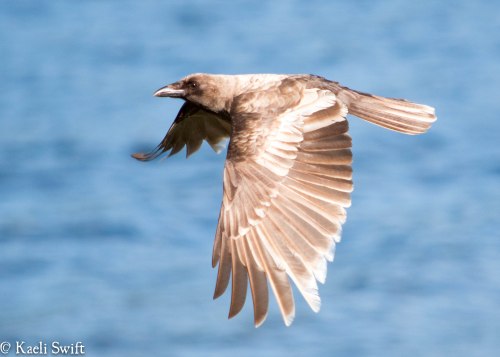
ZB in flight. Photo c/o Sarah Ramirez
At a recent field site in Bellevue, one of my regular visitors was the most fantastically leucistic crow I had ever seen. Naturally, I dubbed him or her “ZB” for Zebra Bird. One or two white feathers is pretty common but this was something far more spectacular. Something that, to the naive observer, may look like a whole different species of bird. In response, I thought it might be helpful to talk about how and why crows have white feathers or other kinds of color aberrations. First off, let’s put some definitions on the table since there are a few terms that often get mixed up, or have different definitions depending on your source. The following definitions are based on those provided by Guay et al. 2012.
Albinism results from a complete lack of melanin in both the feathers and all the soft body tissues. This causes red eyes and pink legs, making it very easy to spot. Albinism is often associated with poor vision and hyper-activity which quickly removes it from the general population and why, when it is spotted, it’s usually only in young or captive birds.

Albino crow spotted in Franklin Park, Seattle*
Leucism is a complete lack of melanin in all or part of the plumage, but not necessarily the soft tissues. It is sometimes referred to as ‘partial albanism’ but if you’re familiar with the definition of albanism (which hopefully you are now!) you know the term ‘partial albinism’ is oxymoronic. Leusistic birds can have one or multiple white feathers, as is the case with my friend in Bellevue, or be completely white but with regularly colored eyes. Their feet and bills may or may not appear pink like that of an albino bird’s.
Schizochrosim is a lack of a particular pigment. So a bird lacking the phaeomelanin (brown) pigment, for example, would appear grey.
Melanism is exceptionally high deposits of melanin that make the animal appear darker overall.
Carotenism is a change in the amount, distribution or composition of caroteniod (red, yellow, orange) pigments.
Dilution is, as the name suggests, a muting of colors across all or part of a bird’s plumage.
How do these color abnormalities arise? There are a couple of different pathways including genetics, diet and injury/disease.
Genetics
Albinism is genetic, specifically, it’s linked to a recessive autosomal gene. If you’re reading this and thinking “autosomal recesisve…what?” remember that humans have 23 pairs of chromosomes. Twenty two of them are autosomal and the last pair are sex chromosomes (you’re either XX or XY, sound familiar?). Recessive means you need two copies of the gene to express the trait. What this mutation does is cause an absence of the enzyme tyrosinase, which is used by the body to create some of the colored pigments. Because albinism is heritable, it can be bred into an artificial population by a skilled breeder, which is why you may see things like white tigers and lions in the entertainment business. Despite their dramatic color variation from their peers, they are not distinct species-an idea I occasionally see being perpetuated on social media. Genetics also plays a role in leucism, though it’s often only part of a more complicated mechanism.

A leucistic dark-eyed junco spotted at my feeder.
Diet
Diets low in protein may also contribute to leucism, as the amino acid lysine has been correlated with increased white feathers. This is supported by the observation that urban birds (who presumably have a diet lower in meat and protein) typically have more color aberrations than their rural or forested peers. Carotenism, on the other hand, is very strongly influenced by diet, since animals cannot produce this color on their own. A very familiar example of this is seeing the white young of flamingos who, in this early stage of life, have not yet had enough time to begin producing mass quantities of their pink pigments.
Age/injury
Lastly, age and injury may also contribute to feathers which fail to correctly pigment though this is poorly understood. Somatic genetic mutation (i.e mutations that occur after conception) are associated with increased age, and indeed, older crows are more often seen with white feathers. Avian Pox is known to play a role in carotenism though not much is understood about this.

ZB’s eye catching leucism in flight. Photo c/o Sarah Ramirez
*Updates* a previous version of this post contained a typo stating that humans have 24 pairs of chromosomes.
A previous version stated incorrectly that a complete leucitic juvenile could be identified by its correctly colored iris. Since blue pigments occur irrelevant of melanin, this is not the case.
Lit cited
Guay, P.J., Potvin, D.A., and Robinson, R.W. 2012. Abberations in plumage coloration in birds. Australian Field Ornithology 29 23-30.














